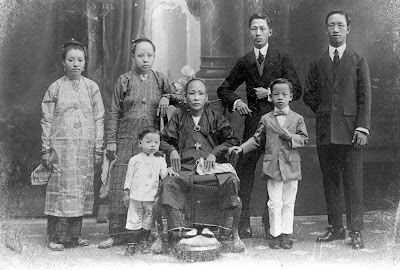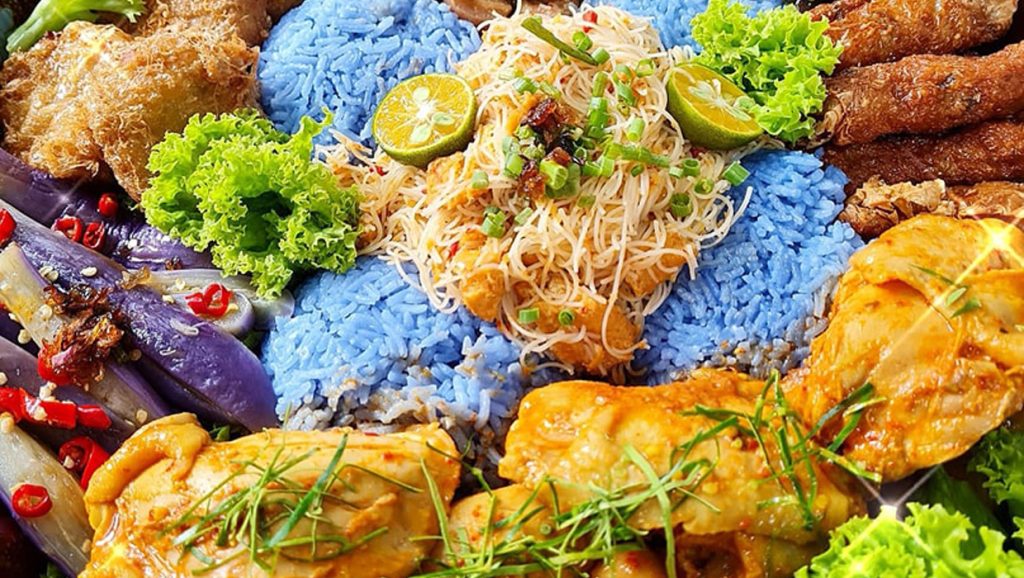Straits Chinese cuisine, or Nyonya cuisine, is a vibrant and unique blend of Chinese and Malay flavors. Developed over centuries in the Straits Settlements (Malacca, Penang, and Singapore), it reflects the rich history of cultural exchange and intermarriage between Chinese immigrants and the local Malay population. This blog post will take you on a culinary journey, exploring the history and some of the signature dishes of this captivating cuisine.

Portrait of A Peranakan family of 1900
A History Steeped in Spice and Tradition
The story of Nyonya cuisine begins with the arrival of Chinese immigrants to the Malay Peninsula centuries ago. These immigrants, primarily Hokkien, Cantonese, and Teochew, married local Malay women, creating a unique cultural fusion that is reflected in their food. The result is a cuisine that is both familiar and exotic, blending the savory techniques of Chinese cooking with the aromatic spices and ingredients of Malay cuisine. This fusion isn’t just a simple combination; it’s a harmonious dance of flavors, textures, and traditions.
Signature Dishes: A Taste of Paradise
Nyonya cuisine boasts a wide array of dishes, each with its own unique story and flavor profile. Here are a few signature dishes that showcase the essence of this culinary tradition: just to name a few:
Ayam Curry Nyonya: is a flavorful and aromatic dish that is a beloved part of Peranakan (Straits Chinese) cuisine. It represents the fusion of Chinese and Malay cooking traditions, offering a unique blend of spices, herbs, and rich coconut milk. Nyonya cuisine, also known as Peranakan cuisine, is renowned for its bold, vibrant flavors and use of fresh ingredients.
Nyonya Curry Chicken (also known as Ayam Curry Nyonya) is a spiced chicken stew that features tender chicken pieces simmered in a fragrant curry sauce made from a mix of herbs, spices, and coconut milk. The dish is characterized by its deep, layered flavors, which come from the use of ingredients like lemongrass, turmeric, garlic, and ginger, all of which are staples in Southeast Asian cooking.
The sauce is thick, creamy, and slightly spicy, with a hint of sweetness from the coconut milk. It’s often served with rice or bread to soak up the delicious sauce, making it a comforting and satisfying meal.

Nyonya Fried Mee Siam: This is a delicious and vibrant dish from the Peranakan or Nyonya cuisine, which blends the culinary traditions of the Malay and Chinese communities in Southeast Asia, particularly in Malaysia and Singapore. This dish features thin rice noodles, stir-fried with a fragrant mix of spices, shrimp, tofu, and egg, all balanced with a sweet-sour, tangy flavor profile that’s characteristic of Nyonya cooking. This dish is a beautiful representation of the Peranakan culture, where local ingredients are elevated through a harmonious combination of flavors. Nyonya Fried Mee Siam is a perfect choice for those who enjoy bold, vibrant, and aromatic dishes, capturing the essence of Malaysia’s multicultural culinary heritage.
Nyonya Kuih: Nyonya Kuih refers to a variety of traditional bite-sized desserts that form an integral part of the Peranakan (Straits Chinese) culinary heritage, known for their delicate flavors and vibrant colors. The term “Nyonya” refers to the female descendants of Chinese immigrants who married local Malays, while “Kueh” (also spelled “Kuih”) simply means “cake” or “dessert” in Malay. These sweet treats have a rich history that blends Chinese and Malay culinary traditions, resulting in an intriguing fusion of flavors, textures, and techniques.
The Peranakan or Straits Chinese people emerged in the 15th to 17th centuries in the Malay Archipelago, particularly in regions such as Malaysia, Singapore, and Indonesia. Over time, the Chinese migrants adapted their culinary practices, incorporating local ingredients and flavors, leading to the birth of Nyonya cuisine, which includes both savory and sweet dishes. Nyonya Kueh is one of the most beloved aspects of this heritage, enjoyed during special occasions, festivals, and family gatherings.
These colorful delicacies were traditionally made from ingredients such as rice flour, coconut milk, palm sugar, and pandan leaves, all of which are abundant in Southeast Asia. The kueh’s intricate preparation often involved steaming or molding into elaborate shapes, showcasing the skill and artistry of the Nyonya women who passed down their recipes through generations.

Beyond the Dishes: A Cultural Heritage
Nyonya cuisine is more than just a collection of recipes; it’s a living testament to a rich cultural heritage. The dishes reflect the creativity and resourcefulness of the Nyonya people, their ability to adapt and innovate while preserving their traditions. Exploring Nyonya cuisine is an opportunity to delve into the history and culture of the Straits Settlements, to appreciate the unique blend of influences that shaped this fascinating culinary tradition.


